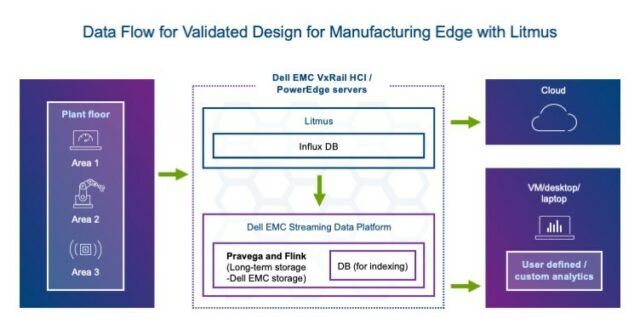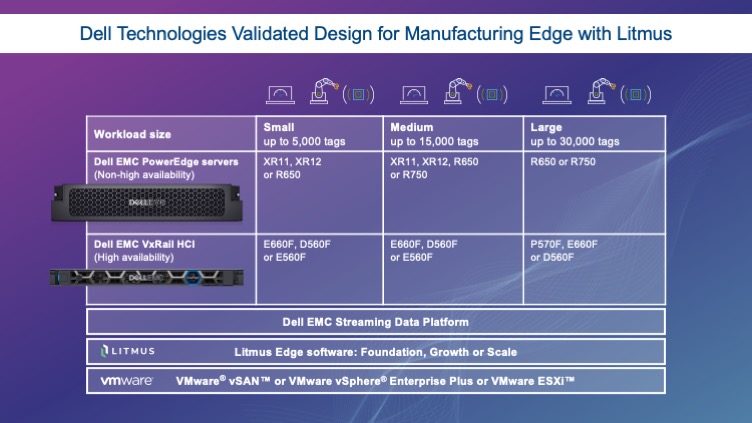Industrial progress has been at the center of human advancement for centuries. Three industrial revolutions brought about major societal transformations:
- Capturing the power of water and steam to mechanize manufacturing.
- Using electricity to create mass-produced consumer goods.
- Leveraging electronic systems to enable robotics and automation.
Today, we are at the threshold of the fourth industrial revolution, referred to by many as Industry 4.0 — Industry 4.0 is being accelerated by the emergence of sophisticated and powerful edge technologies that enable you to act on data near the point of creation to create immediate, essential value.
In an era when data is revolutionizing manufacturing, the ability to collect, analyze and act upon time-critical data is a game-changer. Today’s smart manufacturing plants use powerful technologies like industrial Internet of Things (IIoT), artificial intelligence (AI), machine learning (ML) and streaming data analytics to get real-time insights that enhance business agility with better, faster decisions. These can help you increase overall equipment effectiveness (OEE), perform predictive maintenance, enhance production quality and optimize product yields.
However, the fast ramp to smart manufacturing is fraught with challenges. It requires connecting and managing disparate devices and equipment, merging data streams from multiple sources, building real-time insights and scaling efforts across sites. You need to mitigate risks to security and reliability, and in many cases, it all must happen in remote, harsh and/or space-constrained environments.
Simplify your path to smart manufacturing with a validated, end-to-end edge solution
The Dell Technologies Validated Design for Manufacturing Edge with Litmus is a validated, end-to-end solution designed to centrally manage and orchestrate IIoT and other edge devices, data and applications from the factory floor to the enterprise cloud. The solution is built in partnership with Litmus to accelerate smart manufacturing outcomes.
The Litmus platform built into the solution helps you simplify deployment and integration from the edge to multi-cloud environments, with features such as out-of-the-box connectivity to hundreds of modern and legacy industrial assets, support for containerized applications and cross-factory duplication for faster time to value.
You can gain business agility with live insights using supercharged data persistence at the edge using pre-built and custom data visualizations and AI-/ML-trained models — building a complete data picture from operational technology (OT) to IT, for better and faster decisions on the factory floor and in the boardroom.
This solution combines several proven technologies to win with edge computing in manufacturing. The solution is offered in three different configurations, sized based on workloads, each with the flexibility of subscription-based or CapEx consumption model.
 Dell Technologies Validated Design for Manufacturing Edge with Litmus
Dell Technologies Validated Design for Manufacturing Edge with Litmus
Foundationally, the Dell Technologies Validated Design for Manufacturing Edge with Litmus uses the award-winning hyperconverged infrastructure (HCI) Dell EMC VxRail, which is purpose-built for edge computing in manufacturing to provide high-availability, compute acceleration, AI/ML readiness, low‑latency storage and high-speed connectivity capabilities.
These solutions can thus scale up to any number of assets or sites with ease, resilience and security while centralizing the management and orchestration of your entire edge computing infrastructure at a global scale. For those who don’t need the high availability, Dell Technologies offers configuration options using Dell EMC PowerEdge servers.
The Dell Technologies Validated Design for Manufacturing Edge with Litmus comes integrated with the Dell EMC Streaming Data Platform (SDP) with advanced capabilities to ingest, process and store large streams of data at the edge. It bolsters the data connectivity in the solution with high-speed data persistence and unconstrained storage at the edge. This provides manufacturers the option to run ML training models at the edge using limitless playback of historical data.
With SDP, edge data is leveraged at the point of creation/consumption, thereby not needing to go to the cloud. This helps improve the latency and security of the real-time operational data for edge computing in manufacturing. As the data storage in SDP reaches its limit, you can simply add more storage, without any maximum limit.
 Your edge computing in the manufacturing environment can be further expanded with the latest Dell Technologies portfolio of edge-ready offerings, including Edge Gateway devices, Latitude Rugged Tablets and PCs and Dell EMC PowerEdge servers.
Your edge computing in the manufacturing environment can be further expanded with the latest Dell Technologies portfolio of edge-ready offerings, including Edge Gateway devices, Latitude Rugged Tablets and PCs and Dell EMC PowerEdge servers.
How will you use the Dell Technologies Validated Design for Manufacturing Edge with Litmus?
The Dell Technologies Validated Design for Manufacturing Edge with Litmus gives you the operational intelligence to transform silos of people, assets and processes into a data-driven, synchronized plan that gives OT unmatched visibility into actionable key performance indicators (KPIs). This lends itself well to support several edge computing in manufacturing uses cases that are rooted in business outcomes. Let’s look at how this solution helps support these use cases.
Overall equipment effectiveness
OEE measures manufacturing productivity based on the metrics of quality, performance and availability. This solution helps reduce unplanned downtime while maximizing asset utilization and product quality by using diagnostics and prescriptive analytics to enable intelligent asset optimization. It has a pre-built OEE KPI that makes it simple to gather the right data, visualize it and use it to make improvements.
Predictive maintenance
Predictive maintenance is the practice of using analytics to detect possible equipment and process defects so you can address them before they cause a failure. ML is key to enabling predictive maintenance. This solution collects data from assets, IIoT sensors and machine runtime, normalizes it, monitors it and then triggers a maintenance request when thresholds are reached.
The solution also applies statistical calculations (for example, anomaly detection and signal prediction) to identify and alert to behaviors that indicate impending failure. You can also send the data to the cloud or enterprise platform of your choice for deeper analytics and the application of ML. By leveraging the built-in SDP, you can leverage high-speed data persistence and unconstrained data storage at the edge to train the ML models at the edge without needing to send data to the public cloud. This is a critical capability for OT teams that do not want to move operational data between the factory floor and public cloud due to data latency and security concerns. Using ML, this solution will help uncover previously unknown failure mode patterns from large historical data sets. Trained models are then deployed at the edge to notify both staff and machines.
Yield optimization
Yield optimization refers to predicting production issues before they occur, minimizing downtime of equipment and processes, analyzing the optimal flow of a product throughout its assembly process and detecting anomalies before they result in production pauses. This solution empowers you with predictive analytics and intelligent asset optimization to anticipate interruptions and intervene in real-time. It leverages IIoT sensors, machines, systems and people to help maximize performance and quality while minimizing outages and losses.
Production quality
Production quality is the practice of evaluating the production process to ensure manufactured goods meet quality standards. This solution can help you speed and automate the inspection of work in process throughout the entire production cycle, allowing you to run your computer vision applications (as Docker® applications) to detect defects in products, parts, or packaging to improve safety, decrease liability and keep your customers coming back for more.
Enable smart manufacturing outcomes with Dell Technologies Validated Design for Manufacturing Edge with Litmus
Powered by new technologies for capturing and analyzing data at the edge for new insights and efficiencies, there’s no doubt that the fourth industrial revolution will transform the manufacturing industry, reducing downtime, improving product quality and increasing production capabilities. But like the three revolutions preceding it, the fourth will impact more than just the manufacturing plant. Industry 4.0 won’t just revolutionize the factory floor — it will revolutionize the world.
The Dell Technologies Validated Design for Manufacturing Edge with Litmus simplifies edge deployments with complete visibility for both OT and IT using live insights powered by AI/ML. It fosters IT and OT collaboration on manufacturing outcomes stipulated by the business around OEE, yield optimization, predictive maintenance, asset utilization and more.
Learn more at our edge website.

 Dell Technologies Validated Design for Manufacturing Edge with Litmus
Dell Technologies Validated Design for Manufacturing Edge with Litmus